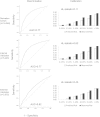Epidemiology and long-term clinical and biologic risk factors for pneumonia in community-dwelling older Americans: analysis of three cohorts
- PMID: 23744106
- PMCID: PMC3760741
- DOI: 10.1378/chest.12-2818
Epidemiology and long-term clinical and biologic risk factors for pneumonia in community-dwelling older Americans: analysis of three cohorts
Abstract
Background: Preventing pneumonia requires better understanding of incidence, mortality, and long-term clinical and biologic risk factors, particularly in younger individuals.
Methods: This was a cohort study in three population-based cohorts of community-dwelling individuals. A derivation cohort (n = 16,260) was used to determine incidence and survival and develop a risk prediction model. The prediction model was validated in two cohorts (n = 8,495). The primary outcome was 10-year risk of pneumonia hospitalization.
Results: The crude and age-adjusted incidences of pneumonia were 6.71 and 9.43 cases/1,000 person-years (10-year risk was 6.15%). The 30-day and 1-year mortality were 16.5% and 31.5%. Although age was the most important risk factor (range of crude incidence rates, 1.69-39.13 cases/1,000 person-years for each 5-year increment from 45-85 years), 38% of pneumonia cases occurred in adults < 65 years of age. The 30-day and 1-year mortality were 12.5% and 25.7% in those < 65 years of age. Although most comorbidities were associated with higher risk of pneumonia, reduced lung function was the most important risk factor (relative risk = 6.61 for severe reduction based on FEV1 by spirometry). A clinical risk prediction model based on age, smoking, and lung function predicted 10-year risk (area under curve [AUC] = 0.77 and Hosmer-Lemeshow [HL] C statistic = 0.12). Model discrimination and calibration were similar in the internal validation cohort (AUC = 0.77; HL C statistic, 0.65) but lower in the external validation cohort (AUC = 0.62; HL C statistic, 0.45). The model also calibrated well in blacks and younger adults. C-reactive protein and IL-6 were associated with higher pneumonia risk but did not improve model performance.
Conclusions: Pneumonia hospitalization is common and associated with high mortality, even in younger healthy adults. Long-term risk of pneumonia can be predicted in community-dwelling adults with a simple clinical risk prediction model.
Figures



References
-
- Simonsen L, Conn LA, Pinner RW, Teutsch SM. Trends in infectious disease hospitalizations in the United States, 1980-1994. Arch Intern Med. 1998;158(17):1923-1928 - PubMed
-
- Yende S, Angus DC, Ali IS, et al. Influence of comorbid conditions on long-term mortality after pneumonia in older people. J Am Geriatr Soc. 2007;55(4):518-525 - PubMed
-
- Herridge MS, Cheung AM, Tansey CM, et al. ; Canadian Critical Care Trials Group One-year outcomes in survivors of the acute respiratory distress syndrome. N Engl J Med. 2003;348(8):683-693 - PubMed
-
- Gail MH, Brinton LA, Byar DP, et al. Projecting individualized probabilities of developing breast cancer for white females who are being examined annually. J Natl Cancer Inst. 1989;81(24):1879-1886 - PubMed
Publication types
MeSH terms
Grants and funding
- R01-AG028050/AG/NIA NIH HHS/United States
- U01 HL080295/HL/NHLBI NIH HHS/United States
- N01 HC085082/HL/NHLBI NIH HHS/United States
- R01-NR012459/NR/NINR NIH HHS/United States
- K23 GM083215/GM/NIGMS NIH HHS/United States
- N01 HC055015/HL/NHLBI NIH HHS/United States
- N01-HC-55021/HC/NHLBI NIH HHS/United States
- R01 NR012459/NR/NINR NIH HHS/United States
- N01-HC-55019/HC/NHLBI NIH HHS/United States
- HHSN268201200036C/HL/NHLBI NIH HHS/United States
- HL080295/HL/NHLBI NIH HHS/United States
- R56 AG023629/AG/NIA NIH HHS/United States
- N01 HC085081/HL/NHLBI NIH HHS/United States
- N01 HC085080/HL/NHLBI NIH HHS/United States
- N01 HC055016/HL/NHLBI NIH HHS/United States
- N01-AG-6-2101/AG/NIA NIH HHS/United States
- N01 HC055019/HL/NHLBI NIH HHS/United States
- N01-HC-55022/HC/NHLBI NIH HHS/United States
- N01-HC-85081/HC/NHLBI NIH HHS/United States
- N01 HC055021/HL/NHLBI NIH HHS/United States
- N01-AG-6-2103/AG/NIA NIH HHS/United States
- HHSN268200800007C/HL/NHLBI NIH HHS/United States
- N01 HC085086/HL/NHLBI NIH HHS/United States
- N01-HC-55016/HC/NHLBI NIH HHS/United States
- N01 HC085083/HL/NHLBI NIH HHS/United States
- N01 HC055020/HL/NHLBI NIH HHS/United States
- N01-HC-85082/HC/NHLBI NIH HHS/United States
- N01-HC-55015/HC/NHLBI NIH HHS/United States
- N01 HC055222/HL/NHLBI NIH HHS/United States
- H01-HC-85086/HC/NHLBI NIH HHS/United States
- N01-HC-55222/HC/NHLBI NIH HHS/United States
- K23GM083215/GM/NIGMS NIH HHS/United States
- N01 HC085079/HL/NHLBI NIH HHS/United States
- N01-HC-85083/HC/NHLBI NIH HHS/United States
- N01-HC-55020/HC/NHLBI NIH HHS/United States
- N01-HC-85080/HC/NHLBI NIH HHS/United States
- R01 HL080295/HL/NHLBI NIH HHS/United States
- R01 AG028050/AG/NIA NIH HHS/United States
- ImNIH/Intramural NIH HHS/United States
- N01-AG-6-2106/AG/NIA NIH HHS/United States
- N01 HC055018/HL/NHLBI NIH HHS/United States
- N01-HC-85079/HC/NHLBI NIH HHS/United States
- N01 HC055022/HL/NHLBI NIH HHS/United States
- AG-023629/AG/NIA NIH HHS/United States
- N01-HC-55018/HC/NHLBI NIH HHS/United States
- R01 AG023629/AG/NIA NIH HHS/United States
LinkOut - more resources
Full Text Sources
Other Literature Sources
Medical
Research Materials

